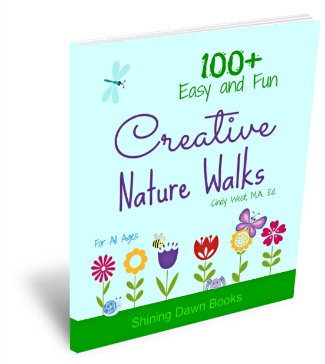Nature walks have been popularized by those following Charlotte Mason’s methods of education, but many implementations of nature walks seem boring. Cindy West transforms nature walks into activities your children are likely to enjoy in 100+ Easy and Fun Creative Nature Walks. In this 63-page ebook, she presents simple ideas that you can do, often with little or no advance preparation. I expect that most homeschooling parents will want to print out the book so that it is easily accessible to thumb through for ideas. While the book has some full-color illustrations, printing it out in black-and-white should work just fine.
Author Cindy West often turns the nature walk into a sort of game as in “Below My Knees” on page nine. The instruction for this walk is one sentence long: “On this walk only note things in your nature journal that are shorter than knee-level.” There are three extension options, one of which makes reads: “Do other similar walks like “below my ankles”, “below my hips”, or “above my head.” Another extension option for “Below My Knees” broadens science learning into critical thinking: “Make a Venn diagram to compare the likenesses and differences between two very different-sized people in your family.” A third option helps children learn to categorize their observations as they, “Make a chart to show the types of items that are no higher than your knee. In other words, note the various flowers, shrubs, rocks, critters, etc. that you find.”
On one walk, students pick up trash. They might categorize the trash and discuss why people discarded it. They might write a letter to the editor regarding the problem of litter. Another activity directs children to collect things that are no longer alive (e.g., leaves, nut shells, twigs, and pebbles) and later make a 3-D art project with the found items (p. 15). A “Compass Trek” teaches orienteering, “Grid It” teaches students to draw what they observe accurately on graph paper. In “I’ve Been Eaten,” children search for evidence that plants have been munched on by creatures large or small. They might assess whether or not the plant is suffering because of the predation. They might observe insects in the process of eating and sketch what they see. In “Look Up,” children simply look up and observe clouds, tree tops, birds, airplanes, or whatever is there.
These are only a few examples of the imaginative diversity in this book. Children might observe, discuss, draw, narrate, compare, measure, explore, write, create, or respond in some other way to what they see. Extension options generally offer at least a few ideas that will challenge older students by requiring sketching, graphing, measurement, or other more-challenging activities. Students should each have their own nature journal in which they will record information from their nature walks in the form of sketches, notes, charts, graphs, etc. You can sometimes make the activities age-appropriate for a wide age span by assigning different activities to your children.
Activities frequently teach practical science in ways rarely found in textbook science courses or even in other resources that include “Charlotte Mason” nature walks. Through these nature walks, children become aware of ecosystems rather than just individual plants or animals. Learning often takes place through discovery. For example, “Who Planted This?” challenges students to think about how the plants they observe got there—Were they planted by people or did they travel there by wind, water, bird poop, or some other transporting mechanism? (p.60).
Families with easy access to a variety of nature settings will certainly find it easiest to implement these nature walks, but even those living in cities and suburbs should find plenty of activities that can be used wherever they live.
100+ Easy and Fun Creative Nature Walks can be used alongside other science courses, or you can use them just for fun since your children might start begging you to do more nature walks after you try a few of these.








